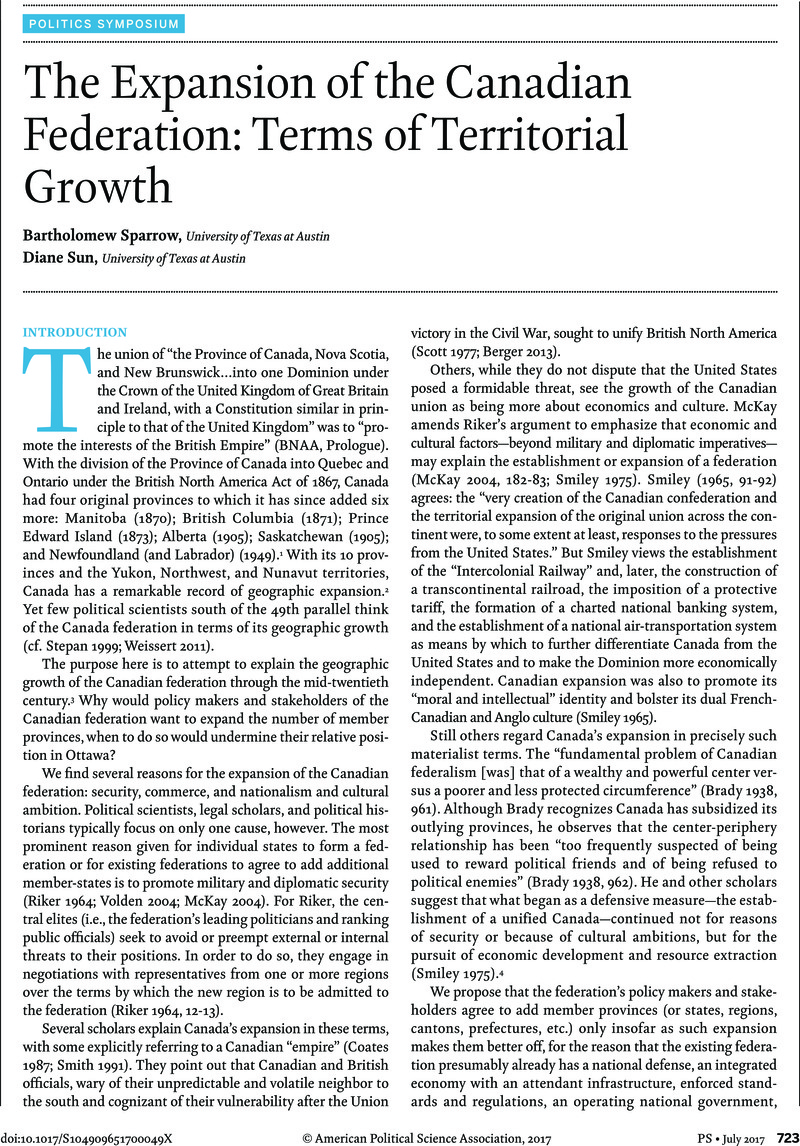No CrossRef data available.
Article contents
The Expansion of the Canadian Federation: Terms of Territorial Growth
Published online by Cambridge University Press: 12 June 2017
Abstract
An abstract is not available for this content so a preview has been provided. Please use the Get access link above for information on how to access this content.

- Type
- Symposium: Canadian Politics at the 150th Anniversary of Confederation
- Information
- Copyright
- Copyright © American Political Science Association 2017
References
REFERENCES
Berger, Carl. 2013 [1970]. The Sense of Power: Studies in the Ideas of Canadian Imperialism, 1867–1914. Second ed. Toronto: University of Toronto Press.CrossRefGoogle Scholar
Biber, Eric. 2004. “The Price of Admission: Causes, Effects, and Patterns of Conditions imposed on States Entering the Union.”
American Journal of Legal History
46 (2): 119–208.Google Scholar
Brady, Alexander. 1938. “The Critical Problems of Canadian Federalism.”
The American Political Science Review
32 (5): 957–65.Google Scholar
British North America Act, 1867. In Documents of the Canadian Constitution, ed. Kennedy, W. P. M. Toronto: Oxford University Press, 665–83.Google Scholar
Cairns, Alex C. 1977. “The Governments and Societies of Canadian Federalism.”
The Canadian Journal of Political Science/Revue canadienne de Science politique
10 (4): 695–725.Google Scholar
Coates, Ken. 1987. “Controlling the Periphery: The Territorial Administration of the Yukon and Alaska, 1867-1959.”
The Pacific Northwest Quarterly
76 (4): 145–151.Google Scholar
Gainer, Walter D. 1976. “Western Disenchantment and the Canadian Federation.”
Proceedings of the Academy of Political Science
32 (2): Canada-United Sates Relations, 40–52.CrossRefGoogle Scholar
McKay, David. 2004. “William Riker on Federalism: Sometimes Wrong but More Right than Anyone Else?”
Regional and Federal Studies
14 (2): 167–86.Google Scholar
Riker, William. 1964. Federalism: Origins, Operation, Significance.
Boston: Little, Brown.Google Scholar
Scott, Frank R. 1977. Essays on the Constitution: Aspects of Canadian Law and Politics.
Toronto: University of Toronto Press.Google Scholar
Smiley, Donald V. 1965. “The Two Themes of Canadian Federalism.”
The Canadian Journal of Economics and Political Science/Revue canadienne d’Economique et de Science politique
31 (1): 80–97.Google Scholar
Smith, David E. 1991. “Empire, Crown, and Canadian Federalism.”
The Canadian Journal of Political Science/Revue canadienne de Science politique
24 (3): 451–73.Google Scholar
Stepan, Alfred. 1999. “Federalism and Democracy: Beyond the US Model.”
Journal of Democracy
10 (4): 19–33.Google Scholar
Thomas, David Yancey. 2001 [1904]. A History of Military Government in Newly Acquired Territory of the United States. Studies in History, Economics and Public Law, Edited by the Faculty of Columbia University, Vol. XX No. 2. William S. Hein & Co.Google Scholar
Volden, Craig. 2004. “Operation, and Significance: The Federalism of William H. Riker.”
Publius
34 (4): 89–107.Google Scholar
Weissert, Carol S. 2011. “Beyond Marble Cakes and Picket Fences: What US Federalism Scholars Can Learn from Comparative Work.”
Journal of Politics
73 (4): 965–79.Google Scholar




